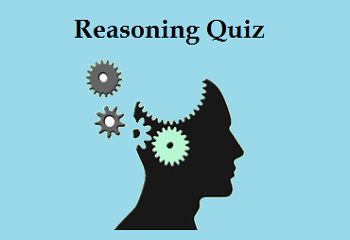Hello Aspirants. Welcome to Online Reasoning Section in AffairsCloud.com. Here we are creating question sample in coded Inequalities, which is common for all the competitive exams. We have included Some questions that are repeatedly asked in bank exams !!
Questions penned by Yogit
Direction: Q(1 – 5)
P & Q – P is neither smaller than nor equal to Q
P@Q – P is neither greater than nor equal to Q
P*Q – P is not smaller than Q
P$Q – P is not greater than Q
P%Q – P is neither greater than nor smaller than Q
- Statements: – A*B, B$C, C%D, D&E
Conclusions: – a) A&C b) D&B
1) Only conclusion 1 follows
2) Only conclusion 2 follows
3) Either 1 or 2 follow
4) Both follow
5) Neither conclusion 1 nor 2 followAnswer – 5) Neither conclusion 1 nor 2 follow
Explanation :
A>= B<=C =D >=E (we can’t say relate A and C and D is greater than and equal to B) - Statements: – A@B, B$C, C*D, D%E
Conclusions: – a) A&D b) C&A
1) Only conclusion 1 follows
2) Only conclusion 2 follows
3) Either 1 or 2 follow
4) Both follow
5) Neither conclusion 1 nor 2 followAnswer – 2) Only conclusion 2 follow
Explanation :
A<B<=C>=D=E (C>A directly follows) - Statements: – A%B, B*C, C@D, D&E
Conclusions: – a) C*A b) B@E
1) Only conclusion 1 follows
2) Only conclusion 2 follows
3) Either 1 or 2 follow
4) Both follow
5) Neither conclusion 1 nor 2 followAnswer –5) Neither conclusion 1 nor 2 follow
Explanation :
A =B>=C<D>E (Directly C>=A and no relation between B and E) - Statements: – M*N, N%O, O%A, A&B
Conclusions: – M&B b) N$A
1) Only conclusion 1 follows
2) Only conclusion 2 follows
3) Either 1 or 2 follow
4) Both follow
5) Neither conclusion 1 nor 2 followAnswer – 1) Only conclusion 1 follows
Explanation :
M>=N=O=A>B (M>N and N= A so second conclusion doesn’t follow) - Statements: – A@B, B%C, C*D, D%E
Conclusions: – a) A&E b) B*D
1) Only conclusion 1 follows
2) Only conclusion 2 follows
3) Either 1 or 2 follow
4) Both follow
5) Neither conclusion 1 nor 2 followAnswer – 2) Only conclusion 2 follows
Explanation :
A<B=C>=D=E (no relation A and E and B>=D directly follows) - What should come in place of question mark in the expression P>Q ? R < T < S so as to make the expressions P>R and S>Q always true?
a) =
b) >
c) <
d) >=
e) None of theseAnswer – a) =
Explanation :
P>Q = R< T < S (Both expression true) - What should come in place of question mark in the expression A = B >C ? D< E = F so as to make the expression F>C always true?
a) >
b) =
c) >=
d) <=
e) both b and dAnswer – e) both b and d
Explanation :
A = B >C = D< E =F and A = B >C <= D< E =F (F>C true in both cases) - Statements: P = S, P < Q, R <= Q, R<= T
Conclusions : a) Q > S b) Q = T
a) Only one follow
b) Only two follow
c) Neither follows
d) Both follow
e) Either followAnswer – a) Only one follow
Explanation :
T>=R<=Q>P=S (clearly Q>S and no relation between Q and T) - Statements: – A > N, K >= N, K > M, R > M
Conclusions: – a) M = N b) R >= A
a) Only one follow
b) Only two follow
c) Neither follows
d) Both follow
e) Either follow
e) None of theseAnswer – c) Neither follows
Explanation :
A>N<=K>M<R (no relation between M and N and R and A) - What should come in place of question mark to make B> D always true?
A = B > C ? D <E
a) >
b) <
c) >=
d) < =
e) both a and cAnswer – e) both a and c
Explanation :
A = B >C >D <E and A = B>C>=D<E in both cases B will be greater than D
Note: Dear Readers if you have any doubt in any chapter in Reasoning you can ask here. We will clear your doubts
AffairsCloud Recommends Oliveboard Mock Test
AffairsCloud Ebook - Support Us to Grow
Govt Jobs by Category
Bank Jobs Notification



